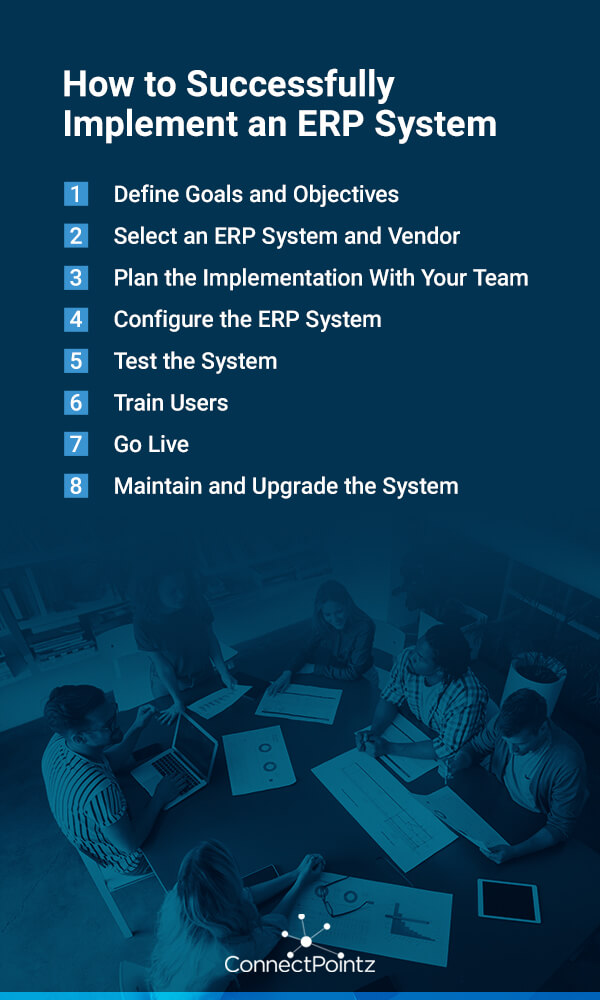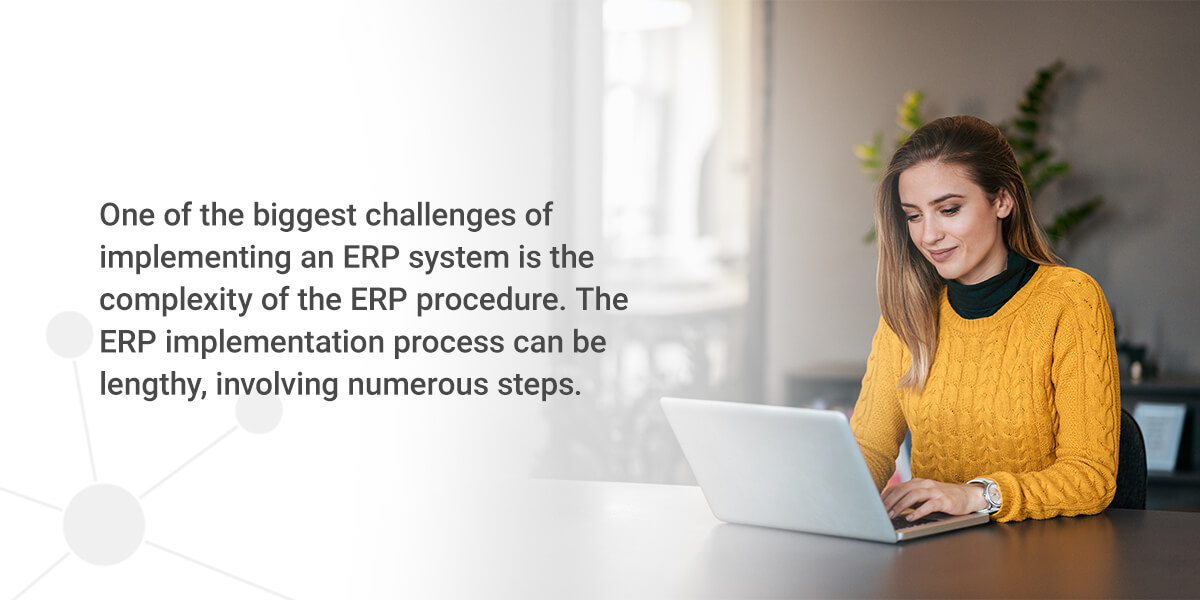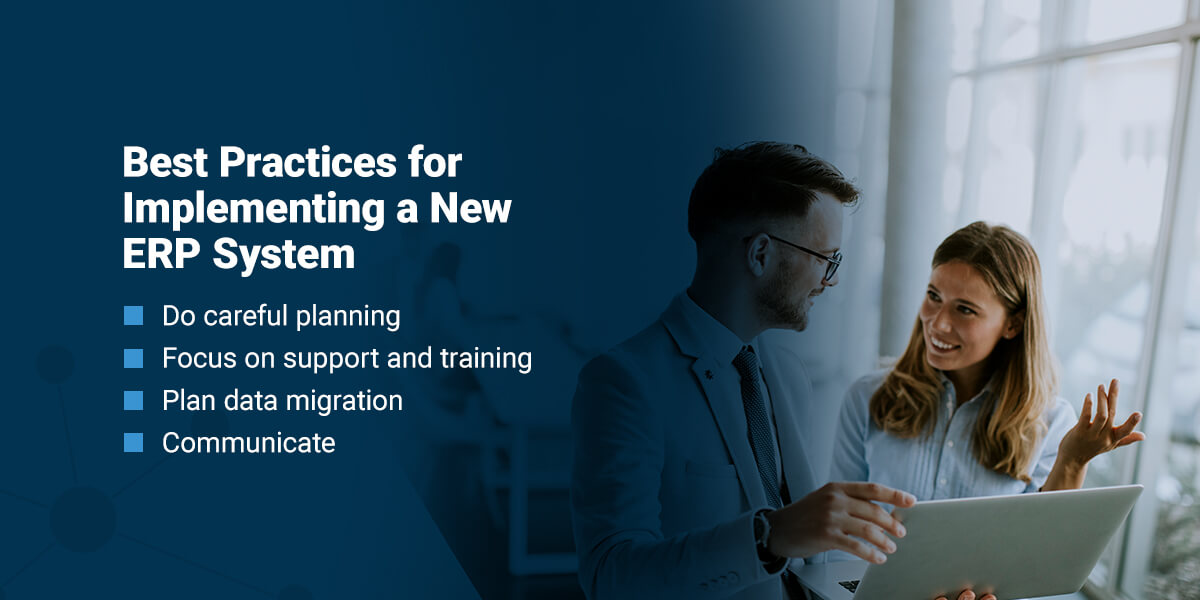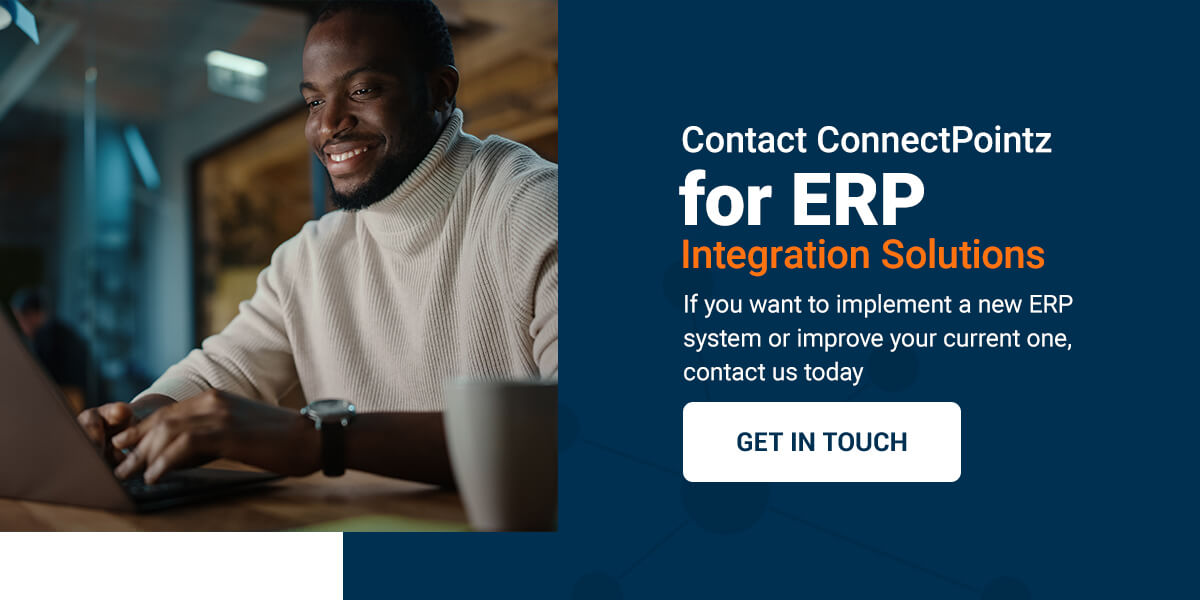
As a business owner or decision-maker for your company, you likely understand the importance of an efficient and effective enterprise resource planning (ERP) system to manage your operations. However, implementing a new ERP system can be complex and require numerous considerations. If you're unsure where to begin, ERP implementation procedures and processes can seem daunting.
Fortunately, you can take numerous steps to make your ERP implementation process flow simple from the start. Below, read everything you need to know about how to implement an ERP system, from the initial planning and preparation stages to the final implementation and training phases, so you can achieve successful ERP system implementation.

What Is an ERP System and How Does One Work?
An ERP software solution integrates and manages various business processes and data into a single, centralized system. An ERP system typically consists of modules covering functions such as finance, inventory management, procurement, human resources and customer relationship management. The primary goal of an ERP system is to streamline and optimize business processes, increase operational efficiency, and provide better visibility into critical data and metrics to support decision-making.
ERP procedures involve collecting data from various departments within an organization and integrating them into a single system that provides a holistic view of the business. This allows decision-makers to track progress, identify inefficiencies and make data-driven decisions. ERP systems are also designed to provide real-time updates, which help improve communication and collaboration across departments.
The implementation of an ERP system requires careful planning and execution, as it involves significant changes to an organization's existing workflows and processes. However, the benefits of implementing an ERP system are substantial and can provide a significant competitive advantage to businesses that take the time to implement them properly.
How to Successfully Implement an ERP System
Implementing an ERP system can be a challenging process, especially if you're new to ERP solutions. Still, with the proper steps, businesses can successfully implement ERP solutions and achieve increased efficiency, better communication and improved decision-making.
Let's discuss the ERP implementation process in eight detailed steps to help inform your implementation procedures:
1. Define Goals and Objectives
Before ERP implementation begins, defining clear goals and objectives is essential. This involves assessing your current business processes, identifying pain points and determining the desired outcomes of the ERP software implementation.
With clear goals and objectives, it can be easier to measure the success of your implementation and ensure that it aligns with your overall business strategy. By defining your goals and objectives, you can create a roadmap for successful enterprise software implementation and increase the likelihood of achieving the desired results.
2. Select an ERP System and Vendor
Selecting the right ERP system and vendor is critical to the implementation process. Start by evaluating your company's requirements and selecting a vendor with industry experience. Look for vendors that offer solutions that fit your budget and are scalable for future growth.
Once you've identified potential vendors, evaluate their implementation process and the level of support they offer. Make sure to involve key stakeholders in the selection process to ensure their needs are met. The goal is to choose an ERP system and vendor to provide the functionality and support you need to meet your business goals.
3. Plan the Implementation With Your Team
Planning is a critical step in the ERP implementation process. This step includes identifying the implementation team's resources, roles and responsibilities. Create a detailed project plan outlining timelines, milestones and potential risks. It's crucial to involve all relevant stakeholders, including department heads, end-users and IT teams.
During the planning stage, it's also essential to identify any potential challenges that may arise during the implementation process and develop strategies to mitigate them. A well-thought-out implementation plan can help ensure the project stays on track, stays within budget and ultimately delivers the desired benefits.
4. Configure the ERP System
Once the implementation plan is in place, businesses can start configuring the ERP system to meet their needs and requirements. This involves customizing settings, workflows and processes to ensure the system aligns with the business's goals and objectives.
A thorough understanding of the business's processes and requirements is critical to configure the system effectively. The configuration process may take time, but it ensures the system is designed to meet specific business needs.
The vendor and the business team work closely during this stage to ensure the ERP system meets the business's requirements and is ready for the testing phase.
5. Test the System
Testing is an essential step in the ERP implementation process. It involves verifying the system's functionality and compatibility with existing systems before going live. This step is crucial, as it ensures the system functions as intended and any issues are identified and fixed before deployment.
Testing should be comprehensive, covering all modules and functions of the system, including user acceptance testing by key stakeholders. It's essential to make sure the system integrates seamlessly with other systems and that data migration and conversion are successful.
Testing should be done in a test environment that mirrors the production environment. Once testing is complete, the system is ready to be launched, and users can be trained to use it effectively.
6. Train Users
Users must be trained on how to use the new system effectively. This includes training for technical users, such as IT staff, and end-users using the system to perform their job functions. Training should cover all aspects of the new ERP system, including data entry, reporting and troubleshooting.
Training can be conducted through a combination of classroom-style instruction, online courses and on-the-job training. Effective training is critical to ensure users are comfortable with the new system and can effectively use it to achieve business goals. Ongoing training and support can also prevent future issues and improve user adoption.
7. Go Live
After thorough testing and user training, it's time to go live with your new ERP system.
Start with a small pilot group and gradually expand to all users. Be prepared for some hiccups and have a support team in place to address any issues that may arise. It's also essential to continuously monitor the system and gather user feedback to identify improvement areas.
With a successful go-live, your organization can benefit from increased efficiency and streamlined processes.
8. Maintain and Upgrade the System
After going live, the implementation process isn't over. Maintaining and upgrading the ERP system is essential to ensure it stays functional, secure and aligned with your business needs. Regular system updates and maintenance are critical for keeping the system up-to-date with the latest features, fixing bugs and addressing security vulnerabilities.
It's crucial to have a plan in place to manage updates and upgrades, test them in a sandbox environment before implementing them in the live system and ensure users are trained on any changes. Additionally, ongoing support and monitoring of the system can help identify and address any issues that may arise, ensuring the ERP system continues to provide value to your business in the long term.
Successful ERP implementation requires businesses to follow specific steps, from defining goals and objectives to maintaining and upgrading the ERP system.

Challenges of Implementing a New ERP System
While implementing an ERP system can bring significant benefits to businesses, there are potential challenges they may face during the process. Awareness of these challenges is essential to mitigate them and ensure a successful ERP implementation.
One of the biggest challenges of implementing an ERP system is the complexity of the ERP procedure. The ERP implementation process can be lengthy, involving numerous steps. This complexity can lead to delays, cost overruns and disruption to business operations.
Another challenge is resistance to change. Employees may resist adopting a new system, especially if it involves changes to their established work processes. The lack of employee buy-in may lead to poor adoption rates, decreased productivity and frustration.
Data migration is another potential challenge when implementing an ERP system. Data migration involves transferring data from legacy systems to the new ERP system. Data may need to be reformatted, cleaned or standardized, which can be tricky and time-consuming. Issues with data migration can lead to data inconsistencies, errors and incomplete data, which can negatively impact business operations.
Also, selecting the right ERP system and vendor is critical. The wrong choice can result in costly customization, inadequate functionality or incompatibility with existing systems. It's essential to conduct thorough research, engage stakeholders and select a reputable vendor to meet the organization's specific needs and requirements.
Overall, while implementing an ERP system can be challenging, by understanding potential challenges and taking steps to mitigate them, businesses can successfully implement an ERP system and realize its benefits.

Best Practices for Implementing New ERP Systems
When you're implementing a new ERP system for your business, you want to make sure you get things right the first time, so you and your team can enjoy the benefits of doing so right away. Here are some key best practices to remember as you go through ERP implementation:
- Do careful planning: Taking the time to define clear goals, objectives and requirements will help ensure the system is configured to meet the needs of the business.
- Focus on support and training: Providing comprehensive training for all employees using the system will help reduce frustration and errors. It's also essential to have a support system to address any issues that may arise quickly.
- Plan data migration: Migrating data from an old system to a new one can be challenging. Planning this process carefully is crucial and includes mapping data fields, cleansing data and testing the migration process.
- Communicate: Keeping employees informed of the implementation process and its goals and benefits will help build support for the new system. It's also vital to communicate any changes to processes or procedures.
Following these best practices can help ensure a smooth implementation process and maximize the benefits of a new ERP system.
Benefits of Integrating Your ERP System
There are numerous advantages that come with enterprise software implementation.
Integrating your ERP system with other systems and platforms is essential for ensuring a seamless flow of data and information across the organization. Integrating your ERP system with other systems can reduce manual data entry costs, eliminate data silos and improve data accuracy.
One of the key benefits of integrating your ERP system is increased efficiency. With integration, you can automate data transfer between systems, eliminating the need for manual data entry, reducing errors and improving productivity. Integrating your ERP system also enables real-time data synchronization, ensuring all systems have the latest information.
Another benefit of integrating your ERP system is improved decision-making. By integrating data from various systems, you can gain insights into different aspects of your business, enabling you to make data-driven decisions. You can also use data visualization tools to analyze data and identify trends and patterns to help you make informed decisions.
By integrating your ERP system with other systems and platforms, you can realize the full potential of your ERP system and optimize your business processes.
Contact ConnectPointz for ERP Integration Solutions
Implementing a new ERP system can be a complex process, but by following the proper ERP implementation steps and partnering with the right experts, you can achieve a successful ERP implementation. At ConnectPointz, we offer ERP integration services to help businesses integrate their ERP system with other systems and platforms.
We specialize in enterprise software implementation and offer pre-configured and custom integration solutions to businesses of all types and sizes. We aim to help companies improve end-to-end automation, meet electronic data interchange compliance standards and streamline their backend processes without human intervention. By partnering with us, businesses can benefit from fewer human errors, higher efficiency and larger profit margins overall.
If you want to implement a new ERP system or improve your current one, contact us today to learn more about how our solutions can help you achieve a successful ERP implementation.










































